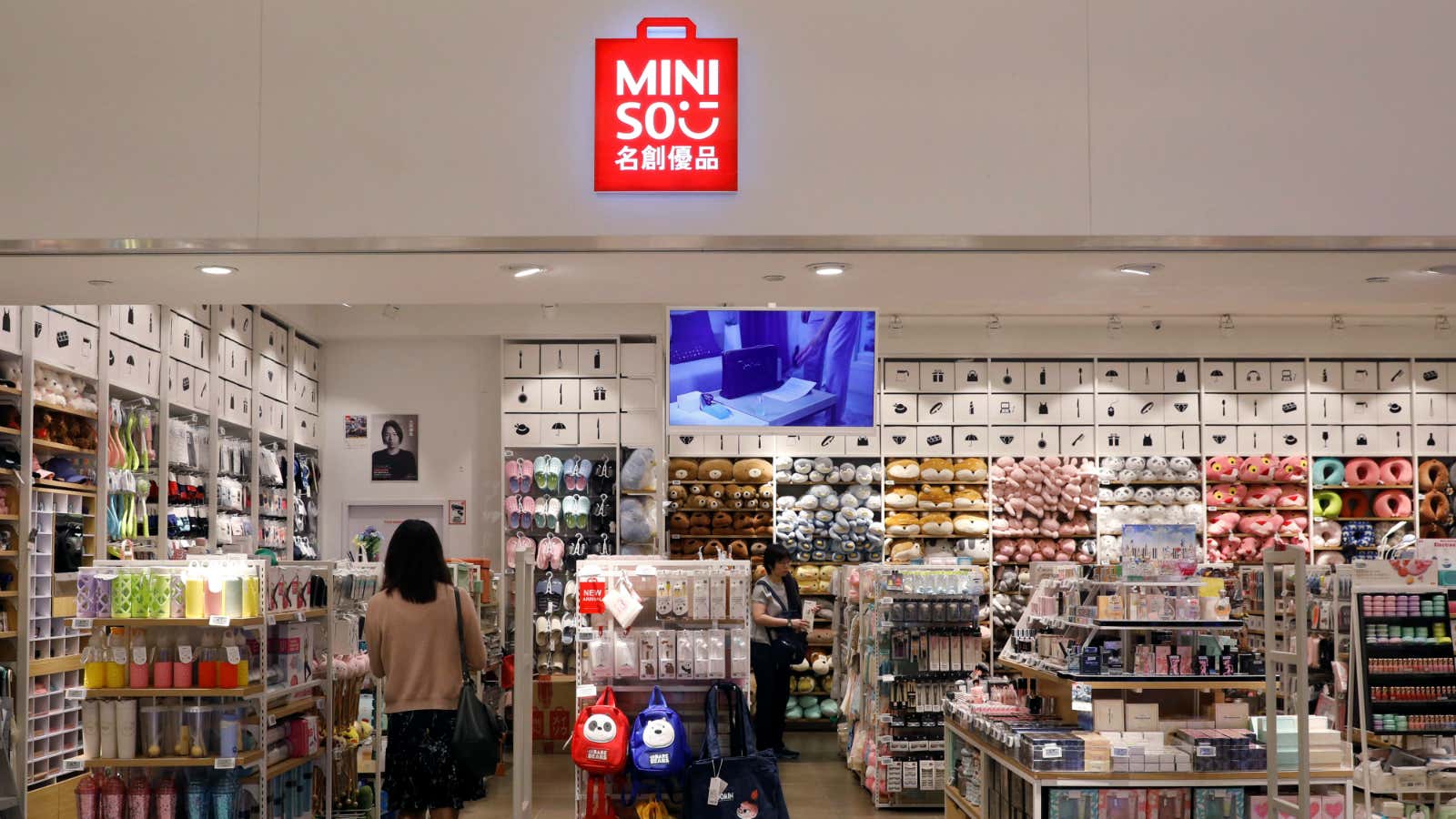The minimalist retailer Miniso has extravagant plans for India.
Just a year after its entry into the country, the Sino-Japanese firm has found a reliable customer base in thrifty Indian shoppers who are spending on its assorted goods like stationery and water bottles. Miniso has already opened 70-odd stores in the country and clocked a turnover of Rs700 crore ($98 million) in India in its first year.
This has made India one of its top three fastest-growing markets.
Encouraged by the response, the brand plans to open 800 stores by 2020, Yang Liu, chief business development officer at Miniso India, told Quartz in an interview. The company is eyeing India’s tier 3 and tier 4 cities and even scouting for franchise partners and possible partnerships to help it scale.
Miniso, best known for its stationery, storage items, cosmetics, and fashion goods, recently raised funds from the Chinese investment firms Tencent and Hillhouse Capital. This will help boost its international presence, Liu said. Miniso is already present in 40 countries, including Canada, the US, Russia, Dubai, North Korea, Hong Kong, Pakistan, Indonesia, and Singapore.
Edited excerpts from the interview with Liu:
What were your plans when you first opened shop in India?
Two years ago we were planning to open as many company-owned stores as possible. We wanted to be present at all the major catchments in India. Unfortunately, we are not a very old and established brand, we are only five years old. So in our first meetings with mall developers, we realised they didn’t understand the model, and they didn’t know Miniso and they didn’t want to put Miniso in their space. Barring a few, not too many were keen. But we got a space at the Ambience Mall in Delhi’s Vasant Kunj area. And there was a good consumer response in that store.
What is working for Miniso in India considering no one had heard about the brand till a year back?
I think we have chosen the right way. We don’t want to add very high margins on our products and we are always working with our manufacturers to get the prices right. We changed our pricing a little bit for India. Compared to markets such as Brazil, and the US, Indian prices are more competitive.
What were the initial challenges faced by the brand here?
One headache for us, on the business side, is we wanted to see more high-quality shopping malls here. If there are better malls, then we can open more stores. Because if you look at the conditions in India, say rainy weather in Mumbai or the summer in Delhi, it isn’t easy for shoppers to shop in high streets. But if you see a shopping mall, you can find everything. Malls definitely work better for us in India, the ticket size is higher.
What are your store targets for India?
We have 67 stores as of today (franchised and company-owned). By 2020, we are targeting 800 stores.
How will you manage 800 stores since you are challenged by the lack of good malls?
Right now we have only opened in major shopping malls in India’s metros. But if you see our prices, and the quality of our products, I don’t think we will face a lot of challenges (in terms of demand) in tier 2, 3, and 4 cities. But the business model could change. Initially, we had company-owned stores but, clearly, no one has the cash flows to open so many stores. So that’s the reason we started a franchise policy in India. Maybe next year we could look at some new business model. It is still being discussed internally.
How has the expansion in smaller markets been so far?
It’s not easy expanding into small Indian cities considering higher freight charges and logistics. Warehousing is a big problem, and we need to figure that out. We have 4,000 SKUs (stock keeping units used in inventory management) in our warehouses. We have three warehouses in India (in the cities of Gurugram, Mumbai)—these are large, high-investment spaces built by our standards. It is expensive to get the products to far-off markets, such as Assam or Mizoram. While the consumer response is incredible, I think we need to re-evaluate our transportation and our SKUs, since we have a large amount of inventory.
What about plans for e-commerce?
It is in our plan. But as a fast fashion company, we start our business from offline retail. So online will be a plus for offline retail in India but it will not be a major market for us. Before we plan our online push we want to make sure all our resources, for now, are focused on our stores.
How would you rate the growth in the Indian market compared with the other countries? What are the highest-selling items here?
India is among the top three fastest growing markets for us—along with Indonesia and Mexico. Bottles and perfumes are selling big here. But we will bring new items like electronics and even beauty products to India in a big way.
Are all your stores profitable?
Our company-owned stores are profitable, at the store level.
Goods sold at Miniso are mostly made in China, could we see some push for local manufacturing and sourcing?
Yes, we have someone from our head office who is responsible for local sourcing. They are figuring out plans with some manufacturers here, so we will finalise that soon. The (made-in India) products should soon be in-stores.
